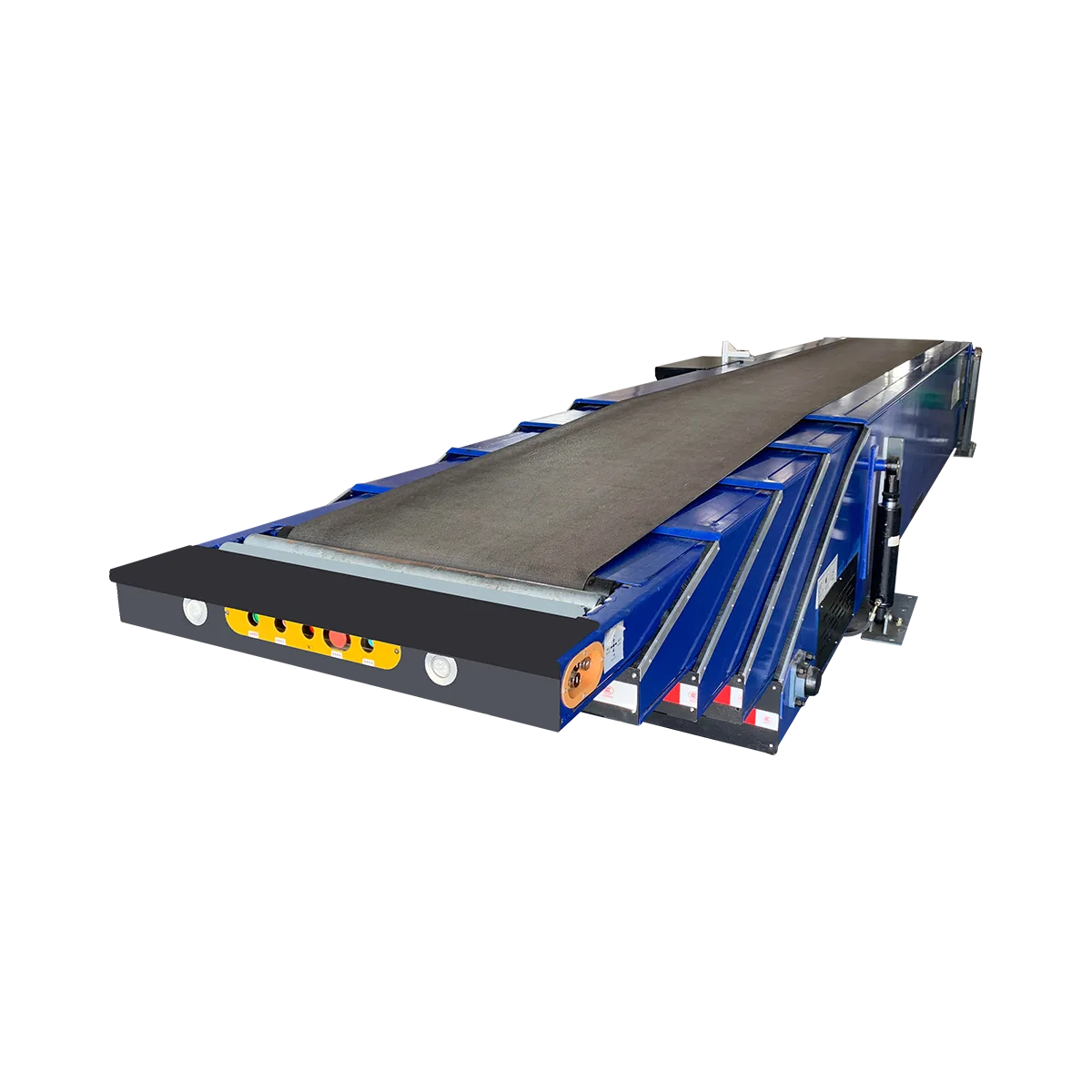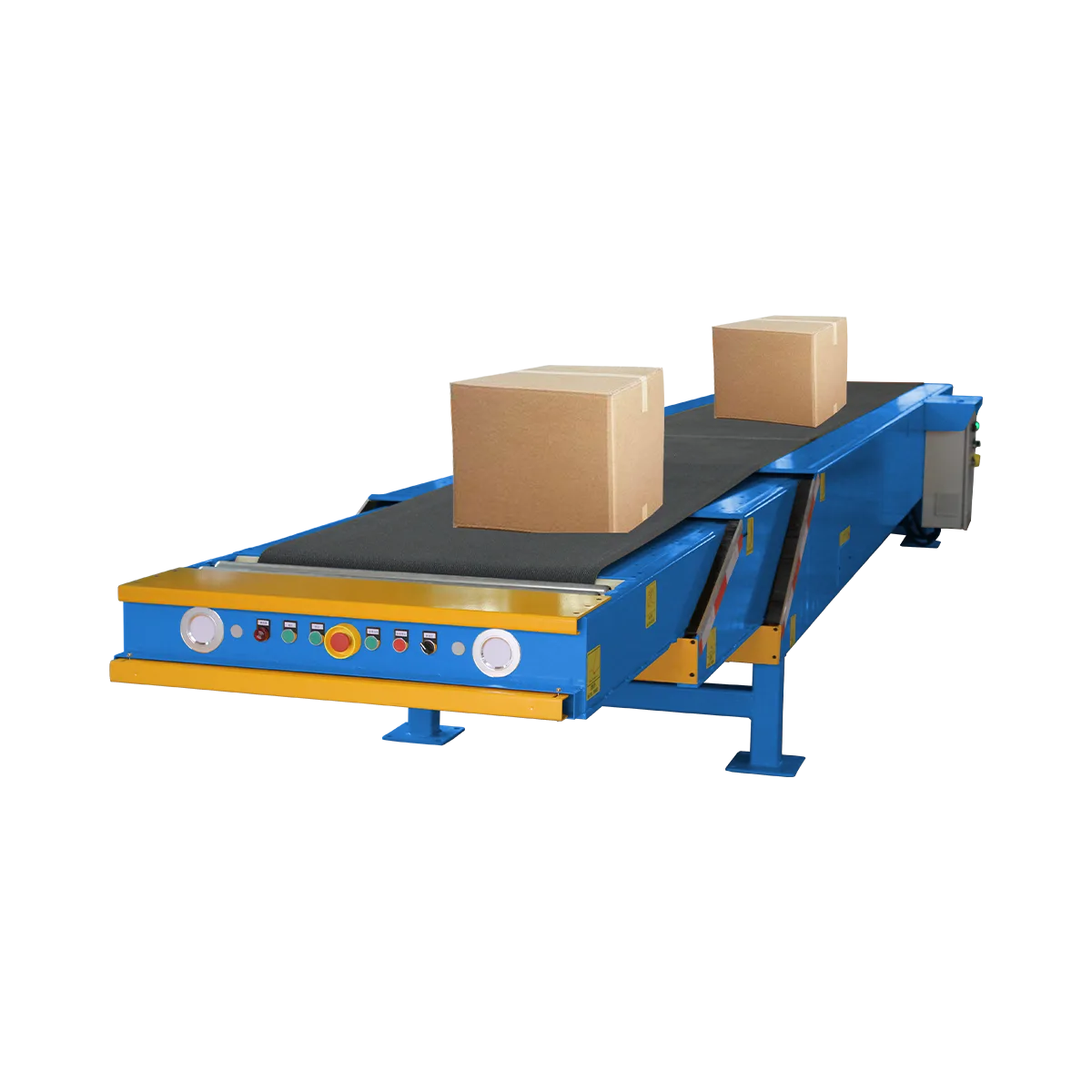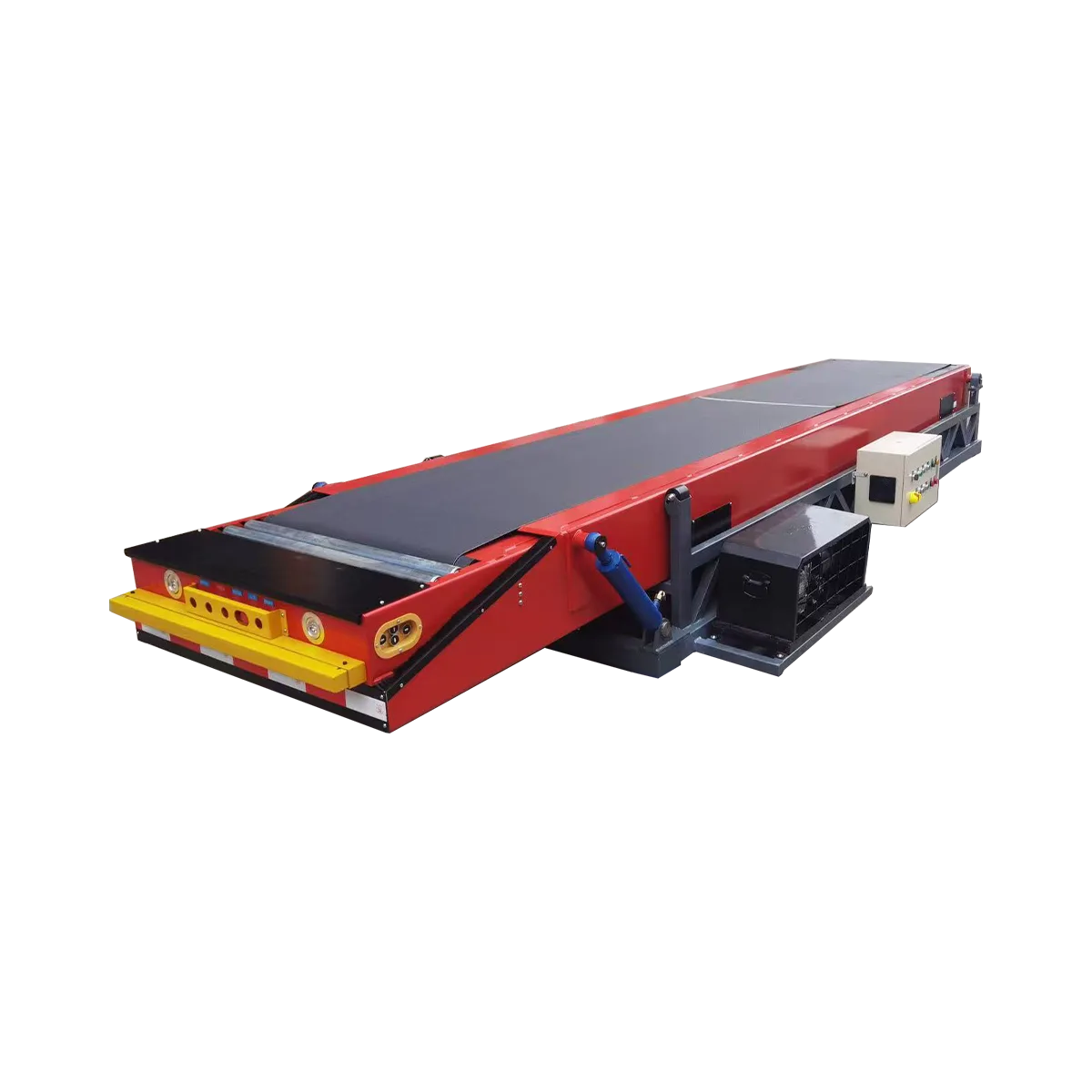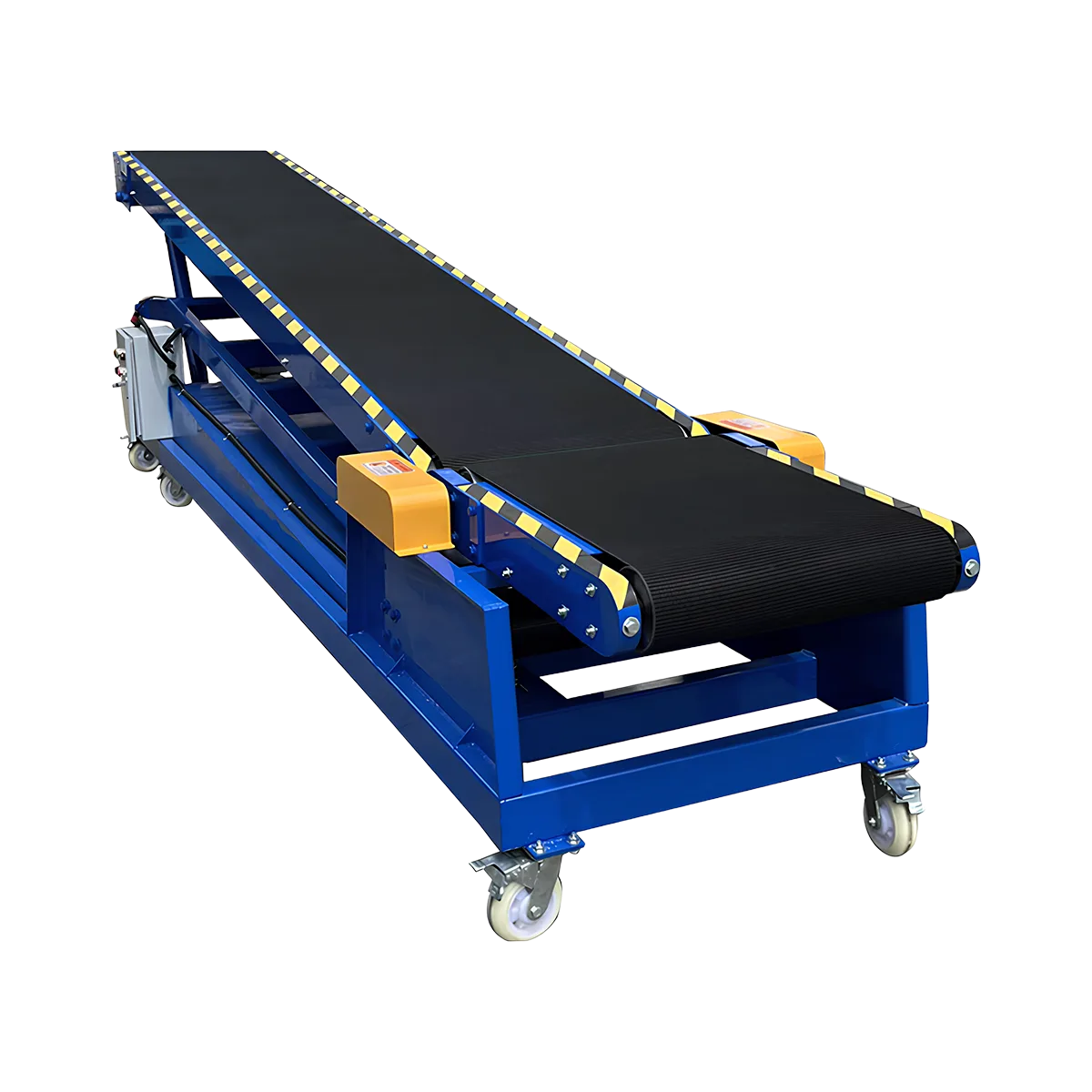Telescopic Conveyor vs. Hydraulic Conveyor: Which Truck Loader is for You?
Compare telescopic conveyor vs hydraulic conveyor systems for your truck loading operations. Discover which dock loader offers the best efficiency, flexibility, and ROI for your specific needs.
Related Products
-
TeleScopic Conveyor – 5 SectionsCollapsed LengthExtended LengthLoad Capacity
60 kg/m
Applicable GoodsFlat-bottomed Goods
Bagged Goods
-
TeleScopic Conveyor – 4 SectionsCollapsed LengthExtended LengthLoad Capacity
60 kg/m
Applicable GoodsFlat-bottomed Goods
Bagged Goods
-
TeleScopic Conveyor – 3 SectionsCollapsed LengthExtended LengthLoad Capacity
60 kg/m
Applicable GoodsFlat-bottomed Goods
Bagged Goods
-
TeleScopic Conveyor – 2 SectionsCollapsed LengthExtended LengthLoad Capacity
60 kg/m
Applicable GoodsFlat-bottomed Goods
Bagged Goods
-
Hydraulic Conveyor – Large – 7900 mm LengthCollapsed LengthExtended LengthLoad Capacity
80 kg/m
Applicable GoodsFlat-bottomed Goods
Bagged Goods
-
Hydraulic Conveyor – Medium – 7000 mm LengthCollapsed LengthExtended LengthLoad Capacity
80 kg/m
Applicable GoodsFlat-bottomed Goods
Bagged Goods
When it comes to efficient truck loading and unloading operations, warehouse managers face a critical decision between two powerful yet fundamentally different systems: telescopic conveyor vs hydraulic conveyor technology. Both solutions excel at moving goods between warehouses and vehicles, but they operate on entirely different principles and excel in distinct operational environments. Making the right choice can dramatically impact your operational efficiency, labor requirements, and ultimately, your bottom line.
The telescopic conveyor represents fixed-installation precision and automation, extending deep into trailers from a dedicated loading dock. The hydraulic conveyor, by contrast, offers unmatched mobility and adaptability, creating an adjustable bridge between ground level and truck beds wherever needed. This comparison will help you understand which truck loading equipment best matches your specific operational needs, space constraints, and budget considerations.
The Fixed Powerhouse: The Telescopic Conveyor
The telescopic conveyor represents the pinnacle of fixed-position loading efficiency. As its name suggests, this system can extend and retract like a telescope, reaching deep into trailers and containers to facilitate rapid loading and unloading operations.
Requires: A dedicated loading dock
The telescopic conveyor is designed as a permanent or semi-permanent installation at a dedicated loading dock. This system requires:
- Fixed loading bay: A properly constructed loading dock with sufficient structural support
- Consistent height: Ideally matched to standard truck bed heights (typically 1.2-1.4m from ground)
- Adequate space: Room for the retracted conveyor plus control systems (5-8m length when retracted)
- Stable power supply: Three-phase power connection for reliable operation
- Level approach: Space for trucks to approach and dock squarely with the loading bay
While the initial installation requirements are more demanding, this investment pays dividends through exceptional operational efficiency once in place.
Best for: High-volume, repetitive loading/unloading where speed is paramount
The telescopic conveyor truly shines in high-throughput environments where:
- Container maximization is critical: Can reach up to 17 meters into 40ft containers
- Speed is essential: Handles 2000-3500 pieces per hour depending on package size
- Labor efficiency matters: Requires only 2 operators regardless of container depth
- Consistent truck types are processed: Works best with standard height trailers
- Dedicated loading bays exist: Permanent installation at fixed loading points
- Bi-directional movement is needed: Supports both loading and unloading operations
The telescopic conveyor’s extendable design eliminates the need for workers to enter deep into trailers, dramatically reducing loading/unloading times while improving worker safety and reducing physical strain.
Key specifications and capabilities
- Extension range: From 5m (two-section) to 25m (five-section) total length
- Bi-directional operation: Supports both loading and unloading
- Speed control: Adjustable 10-40 m/min conveyor speed
- Load capacity: Up to 60 kg/m²
- Available widths: 600mm and 800mm options
- Height: Fixed installation at dock height
- Power requirements: Three-phase power (typically 380V)
- Optional features: Front LED lighting, variable speed control, hydraulic lifting, operation platform
The Mobile Workhorse: The Hydraulic Conveyor
The hydraulic conveyor takes a fundamentally different approach to the loading challenge. Rather than extending horizontally from a fixed dock, it creates an adjustable incline bridge between ground level and truck height, offering unparalleled flexibility.
Requires: A flat patch of ground
One of the hydraulic conveyor’s greatest strengths is its minimal installation requirements:
- Level ground surface: Any reasonably flat, stable surface will suffice
- No permanent fixtures: No need for dedicated loading docks or bays
- Portable power connection: Standard electrical outlet (typically three-phase)
- Maneuvering space: Room to position the conveyor at the optimal angle
- Storage area: Space to store the conveyor when not in use
This minimal infrastructure requirement makes the hydraulic conveyor ideal for operations without purpose-built loading facilities or where loading locations need to change frequently.
Best for: Operations with no dock, varied truck heights, or the need to move the loading point
The hydraulic conveyor excels in scenarios characterized by:
- Absence of loading docks: Perfect for ground-level operations
- Variable vehicle heights: Adjustable elevation from 700mm to 2400mm
- Multiple loading locations: Can be moved between different areas as needed
- Mixed vehicle types: Accommodates everything from small vans to full-size trailers
- Space constraints: Works in areas where permanent dock installation isn’t feasible
- Budget limitations: Lower initial investment compared to dock construction plus telescopic system
The hydraulic conveyor’s adjustable height system creates a smooth transition between ground level and truck bed, enabling efficient loading without the need for permanent infrastructure.
Key specifications and capabilities
- Models: Micro (3700mm), Small (4000mm), Medium (7000mm), and Large (7900mm)
- Height adjustment: From 700mm to 2400mm (model dependent)
- Load capacity: 50-80 kg/m depending on model
- Speed: Adjustable 0.3-30 m/min
- Available widths: 600mm and 800mm options
- Extension capability: Upper support frame can accommodate roller conveyors (up to 12m on Large model)
- Mobility: Heavy-duty casters for repositioning
- Power requirements: Three-phase power (typically 380V)
Feature Smackdown: Automation vs. Portability. Fixed Installation vs. Flexibility.
When deciding between these two powerful loading solutions, understanding their comparative strengths across key operational factors is essential:
| Feature | Telescopic Conveyor | Hydraulic Conveyor | Decision Factor |
|---|---|---|---|
| Installation Requirements | Dedicated loading dock, fixed position, three-phase power | Flat ground, movable, three-phase power | Choose hydraulic if you lack dedicated loading docks |
| Mobility | Limited or none (some models offer wheels but are still heavy) | Highly mobile with heavy-duty casters | Choose hydraulic if loading locations change |
| Reach | Superior (up to 17m into containers) | Limited by base length plus optional roller extensions | Choose telescopic for deep container loading |
| Height Adjustment | Limited (fixed at dock height with optional slight adjustments) | Excellent (700mm to 2400mm range) | Choose hydraulic for variable truck heights |
| Throughput Speed | Faster (handles 2000-3500 pieces/hour) | Moderate (comparable but typically slightly slower) | Choose telescopic for maximum throughput |
| Initial Investment | Higher (plus dock construction if not present) | Lower (no infrastructure requirements) | Choose hydraulic for lower upfront costs |
| Space Requirements | Larger footprint when retracted | Smaller storage footprint | Choose hydraulic for space-constrained operations |
| Operational Complexity | More automated features | Simpler operation | Choose hydraulic for operational simplicity |
| Vehicle Type Flexibility | Best with standard height trailers | Accommodates varied vehicle heights | Choose hydraulic for mixed fleet operations |
The choice ultimately comes down to your specific operational priorities. If you’re handling high volumes at fixed loading points with standard trailers, the telescopic conveyor’s speed and reach are unmatched. If you need flexibility, have variable truck heights, or lack dedicated loading infrastructure, the hydraulic conveyor offers superior adaptability.
The Hybrid Scenario: Can they work together?
A common question is whether these two systems can be integrated to combine their strengths. According to the manufacturer’s specifications, telescopic conveyors and hydraulic conveyors cannot be used together directly. This incompatibility stems from their fundamentally different design approaches and operational mechanics.
However, there is a viable alternative that achieves similar goals: hydraulic conveyors can be effectively paired with powered roller conveyor systems. This combination creates a flexible solution that offers some of the benefits of both approaches:
- The hydraulic conveyor creates the adjustable bridge between ground level and truck height
- The roller conveyor (placed on the hydraulic conveyor’s upper support frame) extends into the truck or container
- This integrated system allows goods to move from warehouse floor to deep within the vehicle
This approach is particularly effective with the Medium and Large hydraulic conveyor models, which can support roller conveyor extensions of 10-12 meters on their upper frames. While not offering the fully automated extension/retraction of a telescopic system, this combination provides excellent flexibility with enhanced reach.
Making the Right Choice: Decision Factors for Your Operation
To determine which system best suits your needs, consider these critical factors:
Infrastructure Assessment
- Existing loading docks: If you already have proper loading docks, telescopic conveyors leverage this investment
- Ground-level operations: Without docks, hydraulic conveyors eliminate the need for expensive construction
- Space constraints: Consider available space for either permanent installation or equipment storage
Operational Analysis
- Loading volume: For operations handling over 1000 packages daily, both systems typically achieve ROI within 6-12 months
- Vehicle variety: Hydraulic conveyors handle greater height variation between vehicles
- Loading locations: Multiple loading points favor the mobility of hydraulic systems
Budget Considerations
- Initial investment: Hydraulic conveyors generally require lower upfront investment
- Infrastructure costs: Factor in dock construction costs if not already present
- Operational savings: Both systems reduce labor requirements from 4-5 workers to just 2
- Maintenance expenses: Both systems have similar maintenance requirements and 5-10 year lifespans
Future Growth Plans
- Expansion possibilities: Consider how each system accommodates future growth
- Flexibility needs: Changing operational patterns may favor hydraulic’s adaptability
- Volume projections: Increasing volumes may justify telescopic’s higher throughput
By carefully evaluating these factors against your specific operational context, you can make an informed decision that optimizes efficiency while controlling costs.
Conclusion: Choose Telescopic for ultimate efficiency at a fixed dock. Choose Hydraulic for ultimate flexibility anywhere else.
The choice between telescopic conveyor vs hydraulic conveyor systems ultimately comes down to your operational environment and priorities. Both solutions dramatically improve efficiency compared to manual loading, but they excel in different scenarios.
Choose a telescopic conveyor when:
- You have dedicated loading docks
- You process high volumes through fixed loading points
- Speed and deep reach into trailers are paramount
- You primarily handle standard-height trailers
- Your operation can justify the higher initial investment for maximum throughput
Choose a hydraulic conveyor when:
- You lack dedicated loading infrastructure
- You need to accommodate variable truck heights
- Your loading locations change frequently
- You have space constraints or storage limitations
- You need a more budget-friendly solution without compromising too much on efficiency
Both systems represent significant advancements in high-volume unloading technology, offering substantial labor savings and efficiency improvements. By matching the right system to your specific operational needs, you can transform your loading dock operations, reduce worker strain, and achieve impressive returns on investment within 6-12 months for operations handling over 1000 packages daily.
Frequently Asked Questions
Can telescopic conveyors work without a loading dock?
No, telescopic conveyors require a fixed loading dock or platform that matches standard truck bed height. Without this infrastructure, a hydraulic conveyor would be the appropriate choice.
How many workers are needed to operate these systems?
Both systems typically require just two workers – one at the entry point placing items on the conveyor and one at the exit point arranging items in the truck or warehouse.
What happens if power fails during operation?
Telescopic conveyors cannot be manually operated or retracted during power failure. Hydraulic conveyors will maintain their position but cannot be adjusted until power is restored. Having backup power is recommended for critical operations.
Which system has lower maintenance requirements?
Both systems have similar maintenance needs. Telescopic conveyors require conveyor belt inspection and bearing lubrication. Hydraulic conveyors need hydraulic fluid checks and seal maintenance. Both systems typically last 5-10 years with proper maintenance.
Can these systems handle all types of packages?
Both systems handle most standard packages up to 60-80kg/m, including boxes, bags, and small equipment with flat bottoms. Neither system is suitable for extremely heavy items (over 100kg per piece) or irregularly shaped objects that cannot sit stably on a conveyor belt.
Table of Contents
Recent Posts
Optimize hardware store logistics with the right building supply conveyor systems. Our guide to tool distribution systems enhances retail warehouse automation for efficient operations.
Optimize your medical supply logistics with efficient gravity conveyor systems. Learn how to safely handle healthcare products while improving your hospital supply chain operations.
Discover how a sports equipment conveyor system can streamline your athletic gear logistics. Flexible conveyor solutions for all shapes and sizes of sporting goods.







